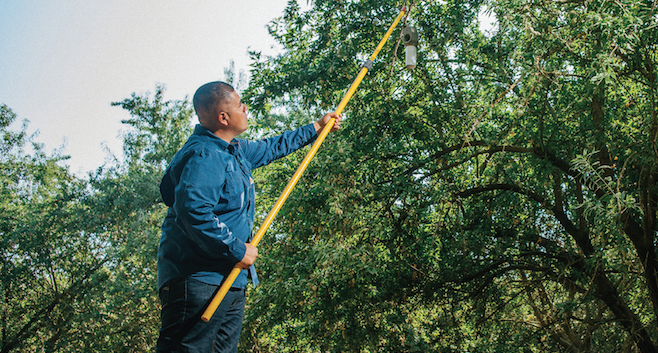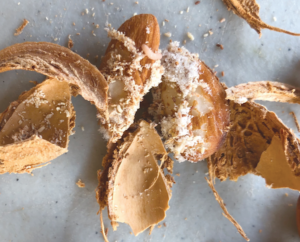
Winter 2021
Make mating disruption a part of your IPM program
Mating disruption has been around for decades. It’s already a staple in apple, pear and other crops for codling moth control, and has now found its way into the mainstream and become an important part of an integrated pest management (IPM) program for some of the California tree nut industry’s toughest pests.
Tree nut acreage in California has increased dramatically over the last four decades, with a 190% increase in just the last 20 years. With this much increase in a host crop, it’s no surprise that navel orangeworm (NOW) populations have proliferated with it.
It is estimated that for NOW, mating disruption is currently used in roughly 400,000 acres of tree nuts out of 2 million bearing acres. This ballpark figure, however, may be low, as mating disruption often goes underreported.
“I think the main, fundamental principle that a grower can have is how to reduce the pest populations inside their orchards every year during the winter, so that going into the spring, they won’t have that big of a problem,” said Jhalendra Rijal, area IPM advisor with University of California Cooperative Extension.
Some industry estimates say that less than 50% of acreage was sanitized in 2019, with other experts saying it’s closer to less than 30%. Bob Klein, manager of the California Pistachio Research Board, mentioned in an interview in early 2020 that the industry suffers roughly $800 billion in losses across all tree nuts due to the costs of control and economic damage caused by NOW.
How it works
Mating disruption research dates back to the 1970s, and pheromonal communication has become less of a mystery. Researchers are able to identify and isolate specific insect pheromones and then replicate them, creating a synthetic female pheromone that can be released in orchards to confuse male insects looking to mate.
Frequency in an orchard varies among the options. Canisters hang at about one per acre, Meso emitters at about 20 per acre and flowables can be sprayed multiple times, depending on pest pressure and labeling instructions. Costs vary, but generally range from $100-120/acre, and some mating disruption companies offer both do-it-yourself and full service options, such as custom orchard mapping for placement, additional moisture monitoring, disease models, and old dispenser recycling, with and without additional charge. Each of these methods use the same pheromone and similar amounts of pheromone over the season.
The layered approach
When mating disruption should enter the IPM scene for a particular orchard should be decided by the grower and the grower’s pest control advisor (PCA). Where it’s needed most depends on the individual orchard, situation, pressure, landscape and surrounding factors. And, due to aflatoxin contamination, navel orangeworm damage must remain low.
Since IPM is a case-by-case, operation-by-operation decision, growers can assess how much damage is eliminated after adding mating disruption, then – after a few seasons of successful use – can consider the possibility of reducing the number of pesticide sprays.
Currently, mating disruption falls in line after thorough orchard sanitation and, at minimum, a pesticide spray at hull split, making mating disruption more effective at further reducing populations. A common mistake among growers, Rijal said, is depending on pesticides to do all the work, thus being lax about — or skipping – sanitation altogether, thinking that the sprays have protected the mummies as well. For a pest as determined as navel orangeworm, even a small unprotected window in the season is enough to cause damage, and leaving mummy nuts to remain on the tree is among the worst scenarios for mating disruption to be effective.

significant economic losses every year. Photo: Jhalendra Rijal, University of California
Becoming more proactive
Depending on the situation, there have been reports of growers being able to skip pesticide sprays because of lower levels of pest pressure. As regulations and consumer and market demands change, there could be more of a move away from pesticides and a move up for mating disruption, bringing it in as the second IPM step after sanitation, and changing current cultural practices.
The shift to more environmentally-friendly products is happening, and a layered and evolving IPM program means there’s a learning curve for how the materials are used and how they fit into a grower’s operation. Each orchard block is different, as is each pest management situation. It can be easy for growers to mistakenly change course once their populations are low, thinking there’s no longer a return on their investment in mating disruption.
“Mating disruption works differently in terms of timing. It’s not an insecticide control, and it doesn’t kill the insect. It is a long-term strategy to have a healthy and productive orchard by reducing the pest pressure in the long run,” Rijal said.
Additionally, current research shows there is no resistance to mating disruption, unlike with the use of pesticides.
Each tree nut has its targets for pest damage, with the almond industry looking at 1-2% and lower before grower premium schedules kick in, and even lower for pistachio at 0-1%. There are reports of some operations that have been running mating disruption for a few years now, and their blocks coming back clean and without any damage. And in these situations, they’re not letting up on their control.
Even if pest pressure is low, the key to maintaining successful levels is simply staying the course of an effective program. NOW can resurge quickly, and successfully achieving low populations is a testament to the importance of mating disruption’s continued use.
“Maybe mating disruption might not be necessary in that particular orchard for that particular year because the pest pressure is low. Even if growers or PCAs can reduce low pressure by another 40-50%, it might not seem economical. But thinking long term, can that grower maintain those levels for the next several years without it?” Rijal said.
Whether a grower can step back on other practices in the future in exchange for mating disruption is a tough call. If mating disruption was used areawide, the odds of success would be greater, though fields would be hardpressed to skip sanitation. For smaller orchards under 40 acres that have several similarly-sized neighbors, Rijal likes to refer to it as a “neighborhood-wide approach,” where mating disruption can be applied to multiple, smaller, adjoining blocks managed by multiple growers to maximize the benefit. Especially since research shows that those with less than 40 acres don’t see as much benefit, especially if the block is irregularly shaped and the neighbors don’t practice good sanitation and management.
As with anything in the field, there are economic factors to consider. For almond orchards that consistently see less than 1% damage with their current program, it may not make financial sense to add mating disruption, but it is possible for growers — after consulting with PCAs and other advisors — to swap sprays for mating disruption, which run about the same in cost. For those with greater than 1-2% percent NOW damage in almond and pistachio, it’s advised to consider adding mating disruption to the IPM program.
Dispersal methods
Currently, there are three main dispersal methods available on the market:
Aerosol canisters
How it works: releases puffs of pheromone at timed intervals at certain durations at night
How many per acre: about one
How long it lasts: all season
Meso emitters
How it works: plastic-like strips have pheromone embedded into the material and release pheromone passively day and night
How long it works: 180 days (all season)
How many per acre: 15-28, with 20 for moderate NOW populations
Flowables/sprayables
How it works: pheromone is micro-encapsulated and sprayed onto trees; mist-like beads slowly release pheromone over time
How long it works: estimated 30 days, depends on pest pressure
How much per acre: about 3 fl. oz. of formulated product per acre, not to exceed 449 fl. oz. of product per acre per year.
There is also research underway with aerial applications applied by fixed wing, helicopter, or drone.







